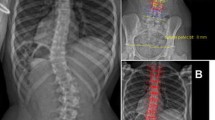Abstract
Purpose
The spinal penetration index (SPI) quantifies the portion of the rib cage occupied by vertebrae. When measured by computed tomography (CT) or magnetic resonance imaging, SPI can only be determined in the reclining position, which modifies spinal and thoracic morphology. CT results in high radiation exposure. The authors studied rib cage and spinal morphology using low-dose biplanar stereoradiography and their impact on respiratory function in adolescent idiopathic scoliosis (AIS).
Methods
In eighty thoracic AIS patients, a slot-scanning radiologic device allowing simultaneous acquisition of orthogonal images and 3D reconstructions with low exposure to radiation (EOS) was used to determine thoracic volume, mean spinal penetration index (SPIm), apical spinal penetration index (SPIa), main thoracic (MT) curve Cobb angle, T4–T12 kyphosis, and apical vertebral rotation (AVR).
Results
Thoracic volume was correlated with thoracic kyphosis (r = 0.31, p = 0.006), but not with SPI, MT Cobb angle, or AVR. SPIm and SPIa were negatively correlated with thoracic kyphosis. Forced vital capacity and forced expiratory volume in 1 s were significantly lower in the hypokyphotic patients (p = 0.04, p = 0.03, respectively) and correlated with thoracic volume and T4–T12 kyphosis. No correlation was found between spinal penetration indices and pulmonary function tests, but SPIm was significantly greater in patients with obstructive syndrome (p = 0.01).
Conclusions
With little radiation exposure, EOS biplanar stereoradiography permits routine imaging is a functional standing position. Hypokyphotic patients had significantly decreased FEV1 and FVC. SPIm was significantly higher in patients with obstructive syndrome.



Similar content being viewed by others
References
Johnston CE, Richards BS, Sucato DJ, Bridwell KH, Lenke LG, Erickson M (2011) Correlation of preoperative deformity magnitude and pulmonary function tests in adolescent idiopathic scoliosis. Spine (Phila Pa 1976) 36:1096–1102
Erkula G, Sponseller PD, Kiter AE (2003) Rib deformity in scoliosis. Eur Spine J 12:281–287
Lonner BS, Auerbach JD, Estreicher MB, Betz RR, Crawford AH, Lenke LG, Newton PO (2009) Pulmonary function changes after various anterior approaches in the treatment of adolescent idiopathic scoliosis. J Spinal Disord Tech 22:551–558
Qiu Y, Sun GQ, Zhu F, Wang WJ, Zhu ZZ (2010) Rib length discrepancy in patients with adolescent idiopathic scoliosis. Stud Health Technol Inform 158:63–66
Takahashi S, Suzuki N, Asazuma T, Kono K, Ono T, Toyama Y (2007) Factors of thoracic cage deformity that affect pulmonary function in adolescent idiopathic thoracic scoliosis. Spine (Phila Pa 1976) 32:106–112
Dubousset J, Wicart P, Pomero V, Barois A, Estournet B (2003) Spinal penetration index: new three-dimensional quantified reference for lordoscoliosis and other spinal deformities. J Orthop Sci 8:41–49
Yazici M, Acaroglu ER, Alanay A, Deviren V, Cila A, Surat A (2001) Measurement of vertebral rotation in standing versus supine position in adolescent idiopathic scoliosis. J Pediatr Orthop 21:252–256
Deschenes S, Charron G, Beaudoin G, Labelle H, Dubois J, Miron MC, Parent S (2010) Diagnostic imaging of spinal deformities: reducing patients radiation dose with a new slot-scanning X-ray imager. Spine (Phila Pa 1976) 35:989–994
Dubousset J, Charpak G, Skalli W, Kalifa G, Lazennec JY (2007) EOS stereo-radiography system: whole-body simultaneous anteroposterior and lateral radiographs with very low radiation dose. Rev Chir Orthop Reparatrice Appar Mot 93:141–143
Humbert L, De Guise JA, Aubert B, Godbout B, Skalli W (2009) 3D reconstruction of the spine from biplanar X-rays using parametric models based on transversal and longitudinal inferences. Med Eng Phys 31:681–687
Ilharreborde B, Steffen JS, Nectoux E, Vital JM, Mazda K, Skalli W, Obeid I (2011) Angle measurement reproducibility using EOS three-dimensional reconstructions in adolescent idiopathic scoliosis treated by posterior instrumentation. Spine (Phila Pa 1976) 36:E1306–E1313
Jolivet E, Sandoz B, Laporte S, Mitton D, Skalli W (2010) Fast 3D reconstruction of the rib cage from biplanar radiographs. Med Biol Eng Comput 48:821–828
Mitton D, Zhao K, Bertrand S, Zhao C, Laporte S, Yang C, An KN, Skalli W (2008) 3D reconstruction of the ribs from lateral and frontal X-rays in comparison to 3D CT-scan reconstruction. J Biomech 41:706–710
Sabourin M, Jolivet E, Miladi L, Wicart P, Rampal V, Skalli W (2010) Three-dimensional stereoradiographic modeling of rib cage before and after spinal growing rod procedures in early-onset scoliosis. Clin Biomech (Bristol, Avon) 25:284–291
Hong JY, Suh SW, Easwar TR, Modi HN, Yang JH, Park JH (2011) Evaluation of the three-dimensional deformities in scoliosis surgery with computed tomography: efficacy and relationship with clinical outcomes. Spine (Phila Pa 1976) 36:E1259–E1265
Labelle H, Aubin CE, Jackson R, Lenke L, Newton P, Parent S (2011) Seeing the spine in 3D: how will it change what we do? J Pediatr Orthop 31:S37–S45
Mao SH, Qiu Y, Zhu ZZ, Zhu F, Liu Z, Wang B (2012) Clinical evaluation of the anterior chest wall deformity in thoracic adolescent idiopathic scoliosis. Spine (Phila Pa 1976) 37:E540–E548
Trawicki M, Liu XC, Tassone C, Thometz J, Lyon R (2010) Improvements in three-dimensional back contour after spinal fusion for idiopathic scoliosis. Stud Health Technol Inform 158:19–23
Kim YJ, Lenke LG, Bridwell KH, Cheh G, Whorton J, Sides B (2007) Prospective pulmonary function comparison following posterior segmental spinal instrumentation and fusion of adolescent idiopathic scoliosis: is there a relationship between major thoracic curve correction and pulmonary function test improvement? Spine (Phila Pa 1976) 32:2685–2693
Newton PO, Faro FD, Gollogly S, Betz RR, Lenke LG, Lowe TG (2005) Results of preoperative pulmonary function testing of adolescents with idiopathic scoliosis. A study of six hundred and thirty-one patients. J Bone Joint Surg Am 87:1937–1946
Weinstein SL (1999) Natural history. Spine (Phila Pa 1976) 24:2592–2600
Conflict of interest
None.
Author information
Authors and Affiliations
Corresponding author
Rights and permissions
About this article
Cite this article
Ilharreborde, B., Dubousset, J., Skalli, W. et al. Spinal penetration index assessment in adolescent idiopathic scoliosis using EOS low-dose biplanar stereoradiography. Eur Spine J 22, 2438–2444 (2013). https://doi.org/10.1007/s00586-013-2892-4
Received:
Revised:
Accepted:
Published:
Issue Date:
DOI: https://doi.org/10.1007/s00586-013-2892-4




